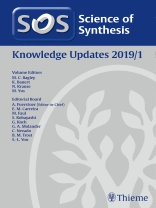The Science of Synthesis Editorial Board, together with the volume editors and authors, is constantly reviewing the whole field of synthetic organic chemistry as presented in Science of Synthesis and evaluating significant developments in synthetic methodology. Several annual volumes updating content across all categories ensure that you always have access to state-of-the-art synthetic methodology.
Tabela de Conteúdo
<p><strong>Volume 3: Compounds of Groups 12 and 11 (Zn, Cd, Hg, Cu, Ag, Au)</strong><br><strong><em>3.6 Product Class 6: Organometallic Complexes of Gold</em></strong><br>3.6.17 Organometallic Gold Catalysis in Combination with Enzyme, Organo-, or Transition-Metal Catalysis<br><strong>Volume 8: Compounds of Group 1 (Li&‌#8943;Cs)</strong><br><strong><em>8.1 Product Class 1: Lithium Compounds</em></strong><br>8.1.6 Product Subclass 6: Lithium Amides<br><strong>Volume 15: Six-Membered Hetarenes with One Nitrogen or Phosphorus Atom</strong><br><strong><em>15.5 Product Class 5: Isoquinolines</em></strong><br>15.5.4 Isoquinolines<br><strong>Volume 18: Four Carbon–Heteroatom Bonds: X–C’X, X=C=X, X2C=X, CX4</strong><br><strong><em>18.12 Product Class 12: Imidic Acids and Derivatives, Isoureas and Derivatives, Sulfur and Selenium Equivalents, and Analogously Substituted Methylenephosphines</em></strong><br>18.12.26 Imidic Acids and Derivatives, Isoureas and Derivatives, Sulfur and Selenium Equivalents, and Analogously Substituted Methylenephosphines<br><strong><em>18.13 Product Class 13: Guanidine Derivatives</em></strong><br>18.13.2 Guanidine Derivatives<br><strong><em>18.14 Product Class 14: Phosphorus Analogues of Guanidine</em></strong><br>18.14.6 Phosphorus Analogues of Guanidine</p>












